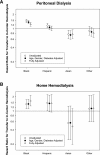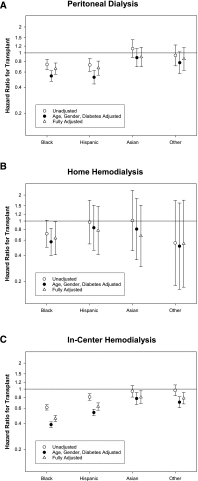Racial and Ethnic Disparities in Use of and Outcomes with Home Dialysis in the United States
- PMID: 26657565
- PMCID: PMC4926974
- DOI: 10.1681/ASN.2015050472
Racial and Ethnic Disparities in Use of and Outcomes with Home Dialysis in the United States
Abstract
Home dialysis, which comprises peritoneal dialysis (PD) or home hemodialysis (home HD), offers patients with ESRD greater flexibility and independence. Although ESRD disproportionately affects racial/ethnic minorities, data on disparities in use and outcomes with home dialysis are sparse. We analyzed data of patients who initiated maintenance dialysis between 2007 and 2011 and were admitted to any of 2217 dialysis facilities in 43 states operated by a single large dialysis organization, with follow-up through December 31, 2011 (n =: 162,050, of which 17,791 underwent PD and 2536 underwent home HD for ≥91 days). Every racial/ethnic minority group was significantly less likely to be treated with home dialysis than whites. Among individuals treated with in-center HD or PD, racial/ethnic minorities had a lower risk for death than whites; among individuals undergoing home HD, only blacks had a significantly lower death risk than whites. Blacks undergoing PD or home HD had a higher risk for transfer to in-center HD than their white counterparts, whereas Asians or others undergoing PD had a lower risk than whites undergoing PD. Blacks irrespective of dialysis modality, Hispanics undergoing PD or in-center HD, and Asians and other racial groups undergoing in-center HD were significantly less likely than white counterparts to receive a kidney transplant. In conclusion, there are racial/ethnic disparities in use of and outcomes with home dialysis in the United States. Disparities in kidney transplantation evident for blacks and Hispanics undergoing home dialysis are similar to those with in-center HD. Future studies should identify modifiable causes for these disparities.
Keywords: end-stage renal disease; hemodialysis; peritoneal dialysis.
Copyright © 2016 by the American Society of Nephrology.
Figures





References
-
- US Renal Data System : Annual Data Report. US Department of Public Health and Human Services, Public Health Service, Bethesda, MD, National Institutes of Health, 2014
-
- Stack AG: Determinants of modality selection among incident US dialysis patients: Results from a national study. J Am Soc Nephrol 13: 1279–1287, 2002 - PubMed

